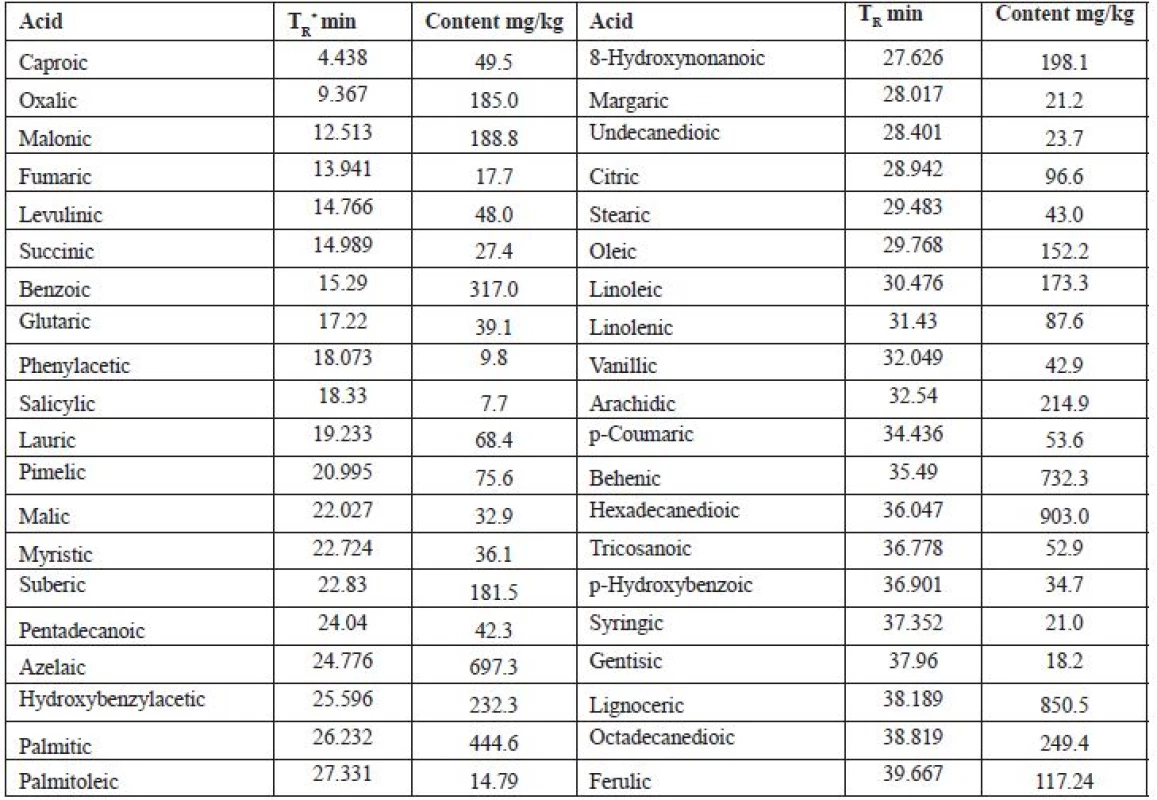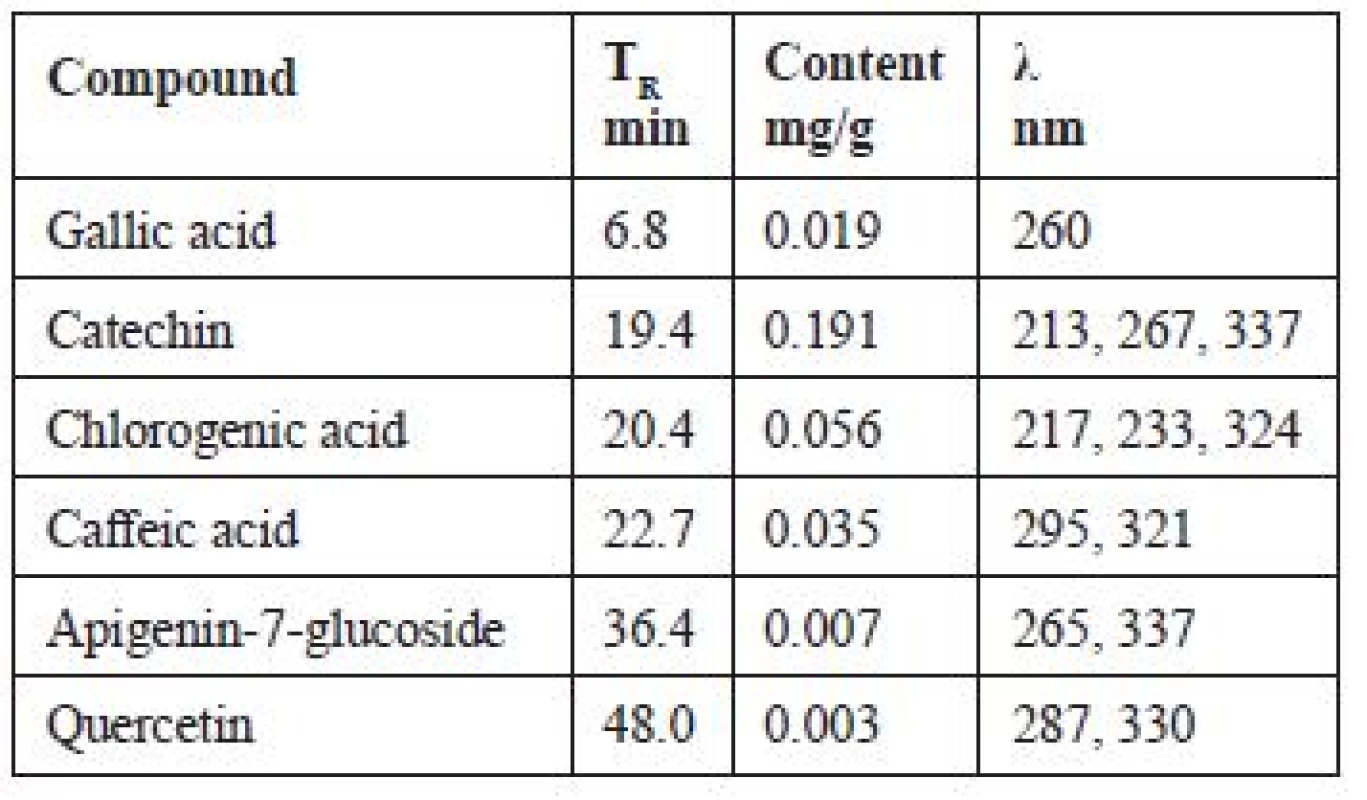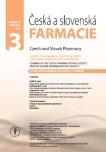Výzkum chemického složení kůry Sorbus aucuparia
Authors:
Elena Krivoruchko; Alexander Markin; Victoria Samoilova; Tetiana Ilina; Oleh Koshovyi
Published in:
Čes. slov. Farm., 2018; 67, 113-115
Category:
Short News
Overview
The quantitative contents of 40 carboxylic acids, with the prevalence of hexadecanedioic, lignocerinic, behenic, azelaic, palmitic and benzoic acids, and 39 components of essential oil were determined in the extracts of the bark of Sorbus aucuparia by the GC-MS method. The quantitative contents of 6 phenolic compounds, i.e., chlorogenic, caffeic, and gallic acids, catechin, quercetin, and apigenin-7-glucoside were determined by the HPLC method in the ethanolic extract of the bark of Sorbus aucuparia.
Key words:
Sorbus aucuparia • bark • carboxylic acids • phenolic compounds • essential oil, GC-MS, HPLC
Introduction
Sorbus aucuparia (European mountain ash, Rowan tree) from the family Rosaceae is widely spread throughout Europe as an ornamental and medicinal plant. Fruits and leaves of S. aucuparia contain vitamins, carbohydrates, organic acids, phenolic compounds and terpenoids, which are known to have an antioxidant, antiscorbutic, diuretic, choleretic, antidiabetic, laxative, or hemostatic effect1–6). Yet, the bark of S. aucuparia has not been given enough attention by researchers. From scattered research it is known that extracts from the bark of Sorbus decora and Sorbus americana have an antidiabetic effect, whereas extracts from the bark of Sorbus commixta have a hepatoprotective effect7–9). The objective of this work was to study carboxylic acids, essential oil and phenolic compounds of the bark of Sorbus aucuparia.
Experimental part
The bark of the branches of S. aucuparia was harvested for analysis in April 2017 in the Botanic Garden of the National University of Pharmacy.
The identification and determination of carboxylic acids in the bark of S. aucuparia was carried out by the HPLC method on an Agilent Technologies 6890 chromatograph with a mass spectrometric detector, 5973N. The sample for the analysis was prepared according to the previously described procedure6). We used the NIST05 and WILEY 2007 mass spectra libraries with a total number of spectra exceeding 470000, in combination with the AMDIS and NIST programs for identification of the components.
Essential oil from the bark of S. aucuparia was obtained by the hydrodistillation method. The determination of essential oil components was carried out on an Agilent Technologies 6890 chromatograph with a 5973N mass spectrometric detector. The procedure of obtaining essential oil and the chromatographic conditions were described earlier10).
The research of phenolic compounds in a 70 % ethanolic extract of the bark of S. aucuparia was carried out by the HPLC method. The Shimadzu LC-20 Prominence module system, equipped with a LC-20AD quaternary pump, a СТО-20А column oven, a SIL-20A autosampler, a SPD-M20A diode array detector and a LC-20 chemstation, was used for data analysis. The chromatographic conditions were described previously11). The identification of phenolic compounds in the ethanolic extract of the bark of S. aucuparia was carried out against the retention time of standards and spectral characteristics.
The results of the research are presented in Tables 1, 2, and 3.



Results and discussion
We determined the contents of 40 carboxylic acids in the bark of S. aucuparia by the GC-MS method as 10 aromatic, 12 dibasic, 1 tribasic, and 17 fatty acids; predominantly hexadecanedioic (903.0 mg/kg), lignoceric (850.5 mg/kg), behenic (732.3 mg/kg), azelaic (697.3 mg/kg), palmitic (444.6 mg/kg) and benzoic acid (317.0 mg/kg). Identified in the essential oil of the bark of S. aucuparia also were 39 components, namely 1 triterpene, 8 aldehydes, 3 alcohols, 3 ketones, 12 fatty acids and 12 alkanes. The oil contains a significant amount of the precursor of numerous triterpenes, i.e., squalene (1283.52 mg/kg). Most identified aldehydes, alcohols and ketones are fragrant substances imparting odour to the raw materials. Identified by the HPLC method also were 6 phenolic compounds in the ethanolic extract of the bark of S. aucuparia. Also determined were 3 phenolic acids, i.e., chlorogenic, caffeic and gallic, and 3 flavonoids, i.e., catechin, quercetin and apigenin-7-glucoside, with chlorogenic acid (0.056 mg/g) prevailing among the acids in the raw material and catechin (0.191 mg/g) prevailing among the flavonoids. Previously, chlorogenic and caffeic acids, catechin and quercetin were found in the leaves and fruit of S. aucuparia, and gallic acid in the fruit of S. aucuparia 2–5). Apigenin-7-glucoside was not identified in S. aucuparia, but it was identified, among the species of the genus Sorbus, in the leaves of S. torminalis12). The results of the present research testify for the importance of further phytochemical and pharmacological studies in the bark of S. aucuparia.
Conflicts of interest: none.
Received: April 18, 2018
Accepted: July 23, 2018
Ass. Prof. Elena V. Krivoruchko, D.Sc. (∗) • V. A. Samoilova • T. V. Ilina • O. M. Koshovyi
National University of Pharmacy
4-Valentynivska str., 61168 Kharkiv, Ukraine
e-mail: evphyto@gmail.com
A. Markin
Pharmacognosy Department, National University of Pharmacy, Kharkiv, Ukraine
Sources
1. Khare C. P. Indian Medicinal Plants. An Illustrated Dictionary. Springer India 2007; 618–619.
2. Raudonis R., Raudone L., Gaivelyte K., Viskelis P., Janulis V. Phenolic and antioxidant profiles of rowan (Sorbus L.) fruits. Nat. Prod. Res. 2014; 28(16), 1231–1240.
3. Olszewska M. A., Michel P. Antioxidant activity of inflorescences, leaves and fruits of three Sorbus species in relation to their polyphenolic composition. Nat. Prod. Res. 2009; 23(16), 1507–1521.
4. Olszewska M. A. Variation in the phenolic content and in vitro antioxidant activity of Sorbus aucuparia leaf extracts during vegetation. Acta Pol. Pharm. 2011; 68(6), 937–944.
5. Olszewska M. A., Presler A., Michel P. Profiling of phenolic compounds and antioxidant activity of dry extracts from the selected Sorbus species. Molecules 2012; 17(3), 3093–3113.
6. Krivoruchko E. V., Andrushchenko О. А., Kononenko A. V. Carboxylic acids from Sorbus aucuparia and Sorbus aria. Chem. Nat. Compd. 2013; 49(4), 742–743.
7. Guerrero-Analco J. A., Martineau L., Saleem A., Madiraju P., Muhammad A., Durst T., Haddad P., Arnason J. T. Bioassay-guided isolation of the antidiabetic principle from Sorbus decora (Rosaceae) used traditionally by the Eeyou Istchee Cree First Nations. J. Nat. Prod. 2010; 73(9), 1519–1523.
8. Lee S. O., Lee H. W., Lee I. S., Im H. G. The pharmacological potential of Sorbus commixta cortex on blood alcohol concentration and hepatic lipid peroxidation in acute alcohol-treated rats. J. Pharm. Pharmacol. 2006; 58(5), 685–693.
9. Saleem A., Liu R., Guerrero-Analco J. A., Bailie A., Foster B., Cuerrier A., Johns T., Haddad P. S., Arnason J. T. An HPLC-ELSD Method for the Determination of Triterpenes in Sorbus decora and Sorbus americana Bark Used by the Eeyou Istchee Cree First Nation. Planta Med. 2016; 82(14), 1302–1307.
10. Osmachko A., Kovaleva A., Goryacha O., Ili’ina T. Сomponents of essential oil of Veronica longifolia L. leaves and flovers. The Pharma Innovation Journal 2014; 3(1), 1–6.
11. Golembiovska O. I. Simultaneous determination of flavonoids and phenolic acids in different parts of Prunella vulgaris L. by high-performance liquid chromatography with photodiode array detection. Int. J. Pharmacog. Phytochem. 2014; 29(1), 1248–1255.
12. Tsitsa-Tzardi E., Loukis A., Philianos S. Constituents of Sorbus torminalis leaves. Fitoterapia 1992; 63(2), 189–190.
Labels
Pharmacy Clinical pharmacologyArticle was published in
Czech and Slovak Pharmacy

2018 Issue 3
Most read in this issue
- Inflammatory bowel disease: factors involved in pathogenesis
- Pharmacy, pharmacists and drugs in the Terezín ghetto
- Biosurfactants and their role in the inhibition of the biofilmforming pathogens
- Imunomodulační aktivita etanolových extraktů z Galium verum L. herb.
